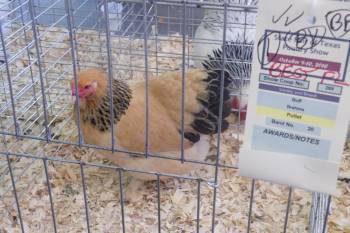Quote:
The Buff Brahma and the Light Brahma are identical in pattern, it is just that the White is replaced with Buff in the Buff Brahma.
So if you read the Standard for the Columbian pattern you will see that your above statement is half right.
This description is for Cocks and Hens.
Neck: Hackles -- web of feathers, lustrous, greenish black with a narrow lacing of Buff; greater portion of shaft black.
Tail: Main Tail -- black, except two top feathers, which are slightly laced in Buff.
Converts -- black, with narrow lacing of Buff.
Wing: Primaries -- black with Buff edging on lower webs.
Male --
Legs and Toes: Shank feathers Buff and Black; outer toe feathering, Buff and Black, where Black, laced with Buff; shank an toe Yellow.
Female --
Shank feathers, Buff; outer toe feathers, Buff and Black, laced with Buff; shank and toes Yellow.
Chris
Since I am still fairly new at this, I would appreciate understanding better which part of my statement you thought was incorrect.
What I was trying to say was that on the Buff Columbian pattern (which is what we're talking about on Buff Brahmas), the "buff" areas of the feathers on the hackles and the saddle are darker, more of a glossy chestnut than the matte buff which is found on the breast area of the males, and the only shade of buff on the females.
The painting in the SOP shows the rooster as a matte buff with the black markings - none of the glossy chestnut. This confused and dismayed me mightily when we first started, because that's not how our males looked. Further investigation has yielded a lot of prizewinning cocks and cockerels with the glossy chestnut tops, and literally zero examples of an all-matte buff columbian male chicken. The description in the standard, I agree, makes no mention of this.
One thing that has always puzzled me is whether if you did somehow produce a male with none of the chestnut tones, but only the matte buff, if that would be considered more desirable.
The Buff Brahma and the Light Brahma are identical in pattern, it is just that the White is replaced with Buff in the Buff Brahma.
So if you read the Standard for the Columbian pattern you will see that your above statement is half right.
This description is for Cocks and Hens.
Neck: Hackles -- web of feathers, lustrous, greenish black with a narrow lacing of Buff; greater portion of shaft black.
Tail: Main Tail -- black, except two top feathers, which are slightly laced in Buff.
Converts -- black, with narrow lacing of Buff.
Wing: Primaries -- black with Buff edging on lower webs.
Male --
Legs and Toes: Shank feathers Buff and Black; outer toe feathering, Buff and Black, where Black, laced with Buff; shank an toe Yellow.
Female --
Shank feathers, Buff; outer toe feathers, Buff and Black, laced with Buff; shank and toes Yellow.
Chris
Since I am still fairly new at this, I would appreciate understanding better which part of my statement you thought was incorrect.
What I was trying to say was that on the Buff Columbian pattern (which is what we're talking about on Buff Brahmas), the "buff" areas of the feathers on the hackles and the saddle are darker, more of a glossy chestnut than the matte buff which is found on the breast area of the males, and the only shade of buff on the females.
The painting in the SOP shows the rooster as a matte buff with the black markings - none of the glossy chestnut. This confused and dismayed me mightily when we first started, because that's not how our males looked. Further investigation has yielded a lot of prizewinning cocks and cockerels with the glossy chestnut tops, and literally zero examples of an all-matte buff columbian male chicken. The description in the standard, I agree, makes no mention of this.
One thing that has always puzzled me is whether if you did somehow produce a male with none of the chestnut tones, but only the matte buff, if that would be considered more desirable.
Last edited:



